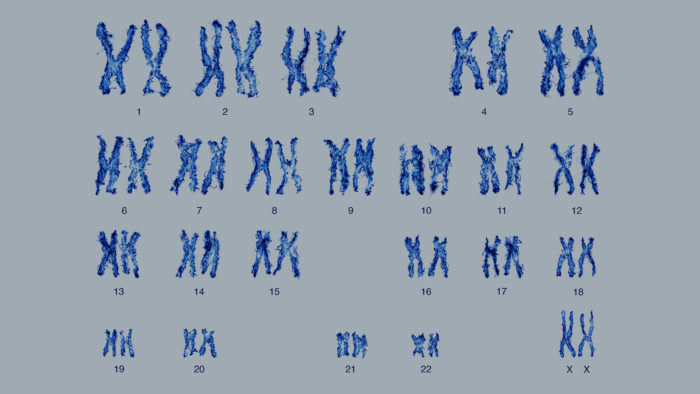Feb 03 2022
Chromosomal Elements Conserved for 600 Million Years
 In evolutionary parlance, “conserved” means that some feature has remained relatively unchanged through some period or within a specific clade. Generally features will change over evolutionary time, either through direct selective pressures or genetic drift through random mutations. Therefore, in order for a biological feature to be conserved there must be selective pressure that keeps it from changing. The longer and more tightly that feature is conserved, the more fundamental it must be to biological function. Histones, for example, are proteins that help manage the long strings of DNA in cells – an extremely basic function for all life. Histones are also one of the most conserved proteins in all of biology.
In evolutionary parlance, “conserved” means that some feature has remained relatively unchanged through some period or within a specific clade. Generally features will change over evolutionary time, either through direct selective pressures or genetic drift through random mutations. Therefore, in order for a biological feature to be conserved there must be selective pressure that keeps it from changing. The longer and more tightly that feature is conserved, the more fundamental it must be to biological function. Histones, for example, are proteins that help manage the long strings of DNA in cells – an extremely basic function for all life. Histones are also one of the most conserved proteins in all of biology.
It is therefore highly interesting that researchers recently found that chromosomal elements are highly conserved in virtually all animal groups over 600 million years – which is basically as long as animals have existed. Chromosomes are the organizing units of DNA. Humans, for example, have 23 pairs of chromosomes. Each chromosome contains a number of genes, and humans have about 20,000 functional genes.
Biologists have long known that sequences of genes tend to sort together – they always occur next to each other on the same chromosome, even across species. However, different clades have different numbers of chromosomes and different gene clusters on different chromosomes. Genes, it seems, get shuffled around during evolutionary history. Scientists and the University of Vienna and the University of California were working together to see if they could make more sense out of this chaos, and that’s what they did.
What they found is that there are fixed chromosomal elements, clusters of genes that always sort together. All animal chromosomes, it seems, have been formed by combining these elements, but the elements themselves are highly conserved, even back to the beginning of the animal clade. These elements can be shuffled around, but they don’t change. At least, they don’t change in terms of which genes they contain. Those genes can change their relative order in the element, which is a feature that is not conserved. You can therefore completely describe the chromosomes of a species by designating which elements are in which chromosomes.
“So now, for example, we can break down each human chromosome into its elements using algebraic notation. Then we deduce what happened to these primordial elements in different species and genera such as corals, molluscs, birds and many others, and what new chromosomes these elements had assembled into,” explains molecular biologist Oleg Simakov from the University of Vienna.
They also found something else that is highly useful for evolutionary biology – once chromosomal elements link up into a chromosome, that process is evolutionarily irreversible. Every descendent species will then inherit the same chromosomal element arrangement. This is extremely useful, because it means the arrangement of chromosomal elements is essentially a map of phylogeny (evolutionary relationships). Every animal group studies so far, from sponges to vertebrates, seems to follow this rule, with a few exceptions (there are always exceptions). The researchers have a lot of work to do exploring more and more groups to see how truly universal the rules they discovered are.
One question, then, is why are these primordial chromosomal elements so conserved? One possibility is that genes that are connected together have some related function, and it’s important that they sort together. Another possibility is that the highly conserved nature of these elements is not due to selective pressure but simply how the genetic machinery works. In order for two multi-cellular creatures to breed and have fertile young, their chromosomes need to line up. Chromosomal changes, obviously, can happen throughout evolution, through rearrangement, fission, or fusion of chromosomes. Chromosomal differences are not an absolute barrier to reproduction, which is how new species with new chromosomal arrangements can arise. But it is a relative barrier and becomes more so as species separate.
The relationship between chromosomal arrangement and evolutionary history is an active and complex area of ongoing research, and this new addition is likely to be a significant advance, adding a layer of mathematical order to this complexity.
This discover also makes more explicit a line of evidence for evolution itself. The sorting of primordial chromosomal elements follows a pattern of nestled hierarchies that evolutionary theory predicts. Again – these chromosomal changes forever define a clade. If evolution were not true, there would be no reason for this pattern to exist. Species and larger groups could theoretically have any arrangement of chromosomal elements, and in fact there would be no reason for conserved primordial elements to exist. They are an artifact of evolutionary history.






